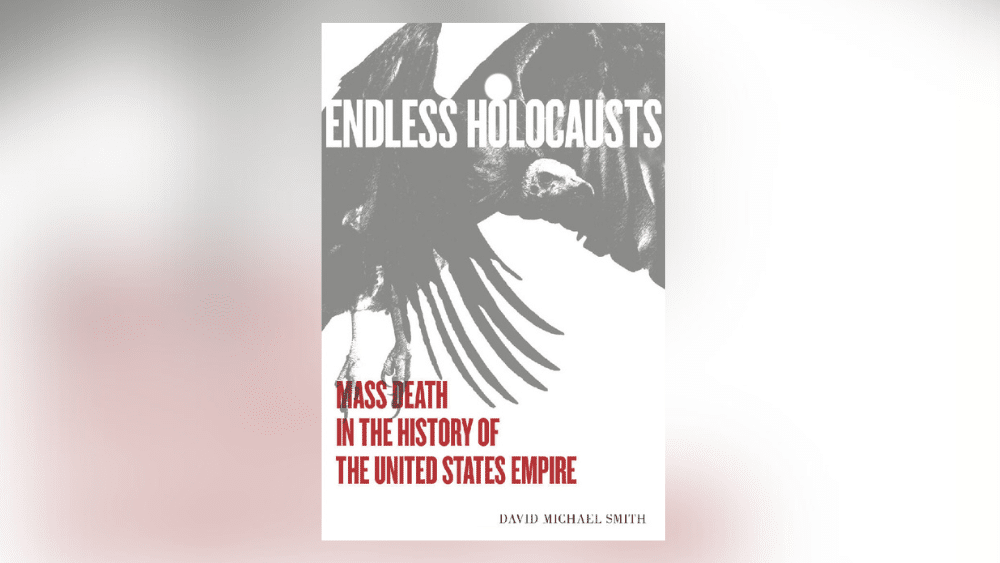- Endless Holocausts – Mass Death in the History of the United States Empire (2023) by David Michael Smith, Monthly Review Press, 504pp, £20.55 paperback
This is a must-read for any and all anti-imperialists and those seeking counter-narratives of US history. Endless Holocausts – Mass Death in the History of the United States Empire by David Michael Smith is less a standard history book, it is more a mini encyclopaedia: it is an invaluable resource, a reference guide to every major atrocity committed by the US from its foundation up to the year 2020.
Smith defines a ‘holocaust’ as a ‘destruction or slaughter on a mass scale’. This radical approach breaks away from the notion that such atrocities are exclusive to supposed ‘rogue nations’, not ‘good guy’ countries like the United States. As a result, Smith’s framing challenges conceptions of western exceptionalism and the idealism surrounding ‘western civilisation’, the US often considered the leading representative of both. It challenges the idea of the US and the ‘West’ as the promoters of liberty and justice. Further, it demonstrates that the atrocities in US history are not simply an embarrassment from the distant past but a consistent behaviour, and in many cases still very much an ongoing issue. Smith writes a history of US imperialism where blood and corpses are not just the foundation, but the very fuel that powers it.
Smith’s approach to US history, as one of ‘empire’, allows us to view this state and its actions, not as something explicable through some innate quality, nor as something specific to the individuals who served as its presidents; but as outgrowths of a settler-colonial project, which developed into a neo-colonial venture. Smith’s book is a covertly socialist work. While it does not openly declare itself a ‘Marxist history’, it is undeniably an example of an historical materialist analysis that centres class in its approach. In fact, Smith dedicates his third chapter to what he calls ‘The Workers Holocaust’, outlining the mass death caused by capitalist exploitation both within the US and those caused by US firms in the countries oppressed by imperialism (or the ‘third world’). His book does not lay blame at the feet of just the US government, but the ruling class it serves.
For Smith, holocausts are not simply those events that target a specific ethnic group (though he does extensively cover the genocide of indigenous peoples and atrocities against black Africans in the US). Here holocausts are ongoing processes which kill vast sections of the global population for the sake of capitalist/imperialist interests. Included among the holocausts Smith identifies are those caused by pollution and environmental catastrophe, as well as those caused by the sale of harmful substances such as tobacco. While not deaths directly ordered by the US government, these are still deaths that were unquestionably caused by US capital, and Smith thus points us to the chief adversary of the world’s labouring masses.
The book’s fourth, fifth and sixth chapters, covering 1775-1945, 1945-1980 and 1980-2020 respectively, present a succinct overview of imperialist incursions in these periods, focusing only on the necessary details.
Among those details is the total death toll, a key focus of the book – a tally of all deaths which Smith connects to the US’s imperialist machine. Smith states in particular that this is the scholarly gap he wishes to fill, to collate together and provide the exact numbers of all those killed by the US Empire. In comparison, the infamous anti-socialist Black Book of Communism provides ridiculously inflated numbers that purport to show the supposed ‘victims of communism’, a work which has been ruthlessly criticised by academics of all political persuasions for its poor scholarly pretences. In contrast, Smith’s ‘Black Book’ is a careful approach to calculating the US’s victims. All estimates are quite conservative and drawn from numbers provided by other academic sources, all of which the book lists. In fact two-fifths of this book’s pages are dedicated to an extraordinary number of incredibly valuable citations, providing those who wish to investigate more with an excellent starting point.
Smith calculates at least 268.5 million deaths, since 1775, caused by both US imperialism and direct capitalist exploitation of both domestic and overseas labour; as well as by numerous other outgrowths of capitalism such as unsafe consumer products, pollution and inadequate healthcare provision. This is over a million deaths per year during the United States’ relatively short existence. This is in addition to US state-led and state-backed tyranny against both indigenous people and African Americans, which he estimates as having led to at least 88 million deaths; though this includes the deaths that laid the foundation of US, prior to 1776, through the early processes of settlement and colonisation. A cumulative total of these death tolls is upwards of 356.5 million.
Much of what Smith cites as mass death caused by the US Empire will undoubtedly be controversial, especially for those who do not understand the relation between capitalism and imperialism. Those who view holocausts as isolated moments of intentional atrocity may not comprehend why they should consider systemic issues such as widespread social violence and life-threatening health issues holocausts in their own right. Smith challenges his readers to break away from individualistic, liberal narratives of historical atrocities and approach the past with a class-based, socialistic outlook. He is refreshingly unapologetic in his approach, with no attempt to justify or explain these atrocities from the perspective of the victimisers.
This book is highly recommended to all those who are just getting started with Marxist literature. Likewise, more seasoned comrades will find it an indispensable resource for their reference, particularly its sheer wealth of citations to help guide their study further.
J S Gupta
FRFI 308 October/November 2025




